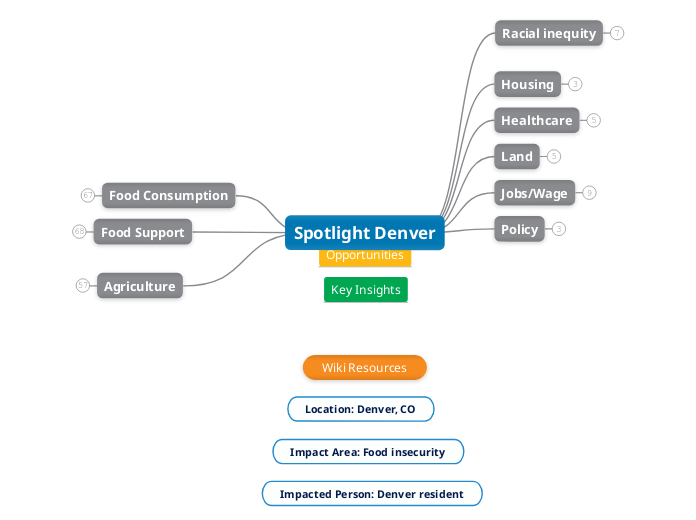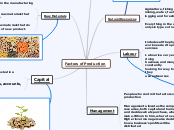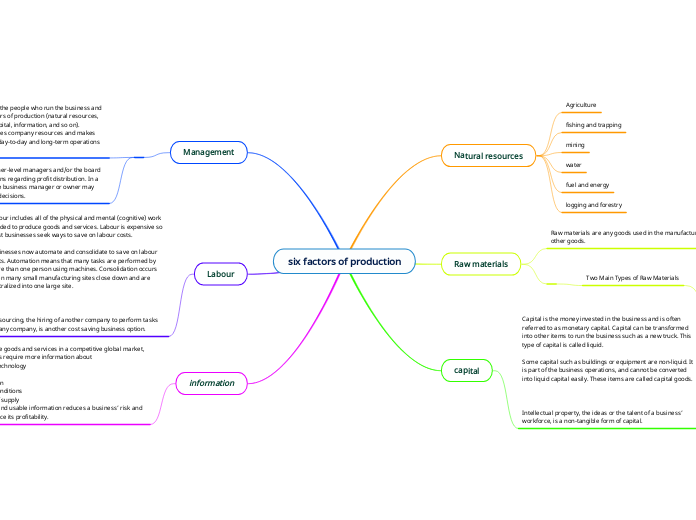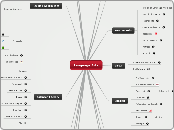Wiki Resources
Impacted Person: Denver resident
Location: Denver, CO
Impact Area: Food insecurity
Key Insights
Opportunities
Spotlight Denver
Agriculture
Ugly food is more popularized now and can reduce waste
Donation incentives
Paid to not grow
Forward contracting needs
Growing selection incentives
Commodity crops
Financing/investment model for CPGs forces higher prices and growth
Many development grants can require businesses to be one year old (reforming new solutions)
Access to capital and land are main pain points for new/startup producers.
Market access
Small farmers and producers need to know there is a market for their product if they are to grow something new or different than what's subsidized.
Direct to Consumer pathways reduce costs and help natural/organic CPGs reach more consumers
Small scale producers struggle with food safety requirements/certification, preventing distribution contract access
Urban Ag
Small Scale Commercial Gardens
People lack access to affordable space to grow their own food.
Urban agriculture is too small to be a significant production source
Community Gardens
Home Gardens
Farmers/workforce
Farm lobby is strong enough to prevent substantial federal program change
Local Ag
Economics of local production suggest it is not the answer to getting healthy foods to low-income communities. (This flies against many policies/incentives)
Local agriculture only accounts for 50k lbs of 40 million lbs of produce moved by Food Bank of the Rockies each year. 0.125%
Farming culture is preventing optimization of existing farm land
Crop variety limited in CO
Farm subsidies prevent farming variety
Fruit and vegetable production is limited in CO
Labor
Aging farmers; lack of succession plan
Wage increases and more employment is good for the worker, but small scale producers will suffer.
Water and labor are main challenges for producers
Procurement
100% local procurement is not a realistic goal
Private sector procurement relationships are already in place. No room for improvement/change
Military procurement model: under the commissary model
Wholesalers
Wholesalers won't service urban markets if they can't purchase $10k or more in an order
Transportation
First mile and last mile of distribution are the most challenging stages of the food supply chain
Food Hub Aggregator
Food distribution company focused on rural grocers
Having product and location data would solve a lot of the food supply chain's problems
Processing
CO Capabilities
TABR severely limits unlocking CO state funds by requiring excess revenue to be redirected back to citizens
More local processing/packaging infrastructure needed to grow and support local producers
Bring manufacturing/processing back to CO to bolster local food system and create jobs/economic development in rural CO
Major production and processing are centered around population centers. CO will "never" have large scale production/processing due to small population.
Food Support
Charitable Food Model
Infrastructure needs
There is a language divide making it hard to connect with many that need food assistance
Toyota Kaizen Approach: using effective methodologies developmed in the private sector for non-profit improvement
Better mobile infrastructure (trailers, food trucks) needed for pantries to reach communities.
Pantries and charitable food organizations lack sufficient cold storage to support better variety
National/regional/local networks
Weave a connection between city departments and leverage resources with one another
Statewide coordination of charitable food network (Oregon model)
Gov't lacks the necessary relationships to take over full food support role
There are too many overlapping service providers. Reduce and better coordinate.
Make pantries anchor institutions that offer more than food.
Increase/allow access to online grocery options (imperfect foods, misfits, etc.) with SNAP
Online shopping/ordering for pantries created during pandemic allowed for greater choice and better quality boxes for recipients.
Source food from not just distributors, retailers, wholesalers, or restaurants; also source from farms across the region
Inefficient daily inventory checking for FBR member pantries
Increase raw/minimally processed food acquisition & pair with cooking, processing, and training to empower people
Food pantry hours of operation need to match those of the folks who need food support
Quality & Nutrition
Very little surplus in restaurants because margins are thin; food obtained are typically near expiration date but not past
Major food bank supplying pantries with poor quality and unpredictable produce, and too many high sugar/processed items.
Demand exists for unhealthy food from charitable food system
Stigma in use
Reduce stigma by making pantry/food bank experience look and feel like any private sector food experience
Inventory planning challenges
"Charitable Food System is buying food to give away - can't that be done directly by people"
Inventory management systems for management of CFU
Reliance on food waste?
Food bank's reliance on rescued foods impacts ability to provide predictable quality and variety to customers
Pantries lack inventory tracking ability. MetroCaring only tracks items taken by shoppers by weight, not item type.
Lack of data
Labor and cost to scan data is preventing more sophisticated data on food
Lack of shared information, communication, and granular data in supply chain waste; prevents how surplus food could best be repurposed
Root cause of food supply chain messiness is the lack of structure of the data and rare digitization of data
Fragmentation of data maintains the status quo in the food supply chain
School Lunch Funding
Reallocation of school food funds (P-EBT) is a threatening conversation for school food directors
SNAP
[https://wiki.newimpact.care/s/dataseeder/goto/6b56ef0b6cbfcb5d527b169d13f009a6?embed SNAP resources]
SNAP dollar only lasts two weeks
More SNAP users benefits the private sector
Removing the SNAP interview requirement as an temporary emergency COVID practice saw no negative verification changes/impacts (in Oregon).
SNAP outreach funding is underutilized. Media campaign is needed to support SNAP awareness.
SNAP enrollment and verification requirements prevent entry and increase churn/falloff
SNAP benefit limit is too low and creates a barrier to enrollment considering the enrollment requirements
In Douglas County, 70% of food bank attendees were not enrolled in SNAP
Doctors and nurses lack training and tools to increase screening for social and economic barriers in patient visits. Pilots show this could increase cross enrollment.
Resources and support for people experiencing food insecurity are often in disparate places
There is a tech divide - high speed internet, tech skills/literacy, cost - that makes it hard to connect with many that need food assistance
People facing urgent need for emergency help (shelter, food, employment) often have to go to multiple government/social providers for different services
Sign up process limiting participation
Economics
Implementation Requirements
Difficult for emergency food providers to track all necessary data for federal program reimbursement
People need to be educated on the true cost of food. They might pay more for organic and natural foods if they knew the economic, social and environmental benefits included in the cost.
Food is expensive. Minimum wage is low, rent is high and there isn't enough money left for food.
Programs that complement food
Cooking
Nonprofit partnership with culinary schools to create ethic/culture based on cooking practices
The further people have gotten away from the source of food, the less we seem to care about it. Can local ag scale up for more regional use?
In down months (Nov-Apr), institutions can highlight individual items (i.e. carrots) to spread awareness/spark taste for local produce
Food Consumption
Waste
Consumer
Human relations are needed to get adoption of an idea; how do you put the human connection when dealing with the issue of food waste?
Retail
Food supply chain players overstock to be able to answer any call from the next part of the chain, but that leads to waste at each step
Grocers are incentivized to throw food out
Food Banks/Pantries
Corporate Donations
FBR chooses to accept chips to satisfy partner orgs
Food Rescue
Private sector tech/inventory mgmt gains reducing available food rescue supply for pantries
Production
People have improved distribution centers for food, but no one looks up the supply chain
No set standard for measuring food waste
Businesses are incentivized (taxes) to donate older food rather than find a market based solution
Consumer Consumption
Food Options
Convenience Items
School meals
Prepared meals
Raw grocery products
Preparation
Time
Access to kitchen
Middle-income folks cook the most. Leads to best direct to consumer markets.
Knowledge
Distribution
SNAP is a farm subsidy program. Funded by the USDA. Not a nutrition program. Food banks have to fill in the gap of nutritious food.
Most important issue in food insecurity is with children. They lack choice/power and are getting poor quality food and health issues.
Cost
People expect cheap food. The $1 menu has been the same price for years.
Convenience
Hours
Proximity
Cultural Relevance
Using data to understand where to deliver culturally appropriate food
Quality
Absolute hunger isn't the problem; instead, its the inability to feed families nourishing food
Shelf stable, poor quality foods (chips, sodas, etc.) are low risk for grocers to stock b/c distributors supply/stock products for them.
Access
Why can we reach every home to trash pickup but not for food deliver/distribution?
Where people get food
Schools
Public schools can be major leverage points for food insecurity
School lunches are key opportunities to impact 1/3 of child daily food
Fresh, nutritious even if not local is a big win in school lunches
Restaurants
Direct to consumer
Food Trucks
Sit-down dining
Fast Food
Convenience Stores
Convenience store options prevalent in many communities don't offer fresh/healthy items; charge exorbitant prices for key staples
Convenience stores are often major food access points in low income areas
Cheap cornerstores/gas stations change economics and access of unhealthy foods making bad food easier to get AND more expensive that at grocery stores
Grocery Stores
Online delivery services
Co-op
Increase local ownership of urban and rural grocers.
Legal complexities/cost to start a co-op increase risk for non-wealthy entrepreneurs
Large Chain
Small/local specialty stores
Farmers Markets
Butcher shops
Ethnic food stores
Charitable food banks
Policy
Subtopic
Farming
Public benefits
Jobs/Wage
Entrepreneurship
Mentorship
Financing access
Decent wage
Minimum wage
Reliable jobs
Entrepreneurship hurdes
Multiple job
Seasonaility
Land
Consolidation
Aging farmers
Crop rotation
Subsidies/incentives
Farm Land
Healthcare
Prevention vs treatment costs
Obesity
Nutrition
Dietary restrictions
Insurance savings
Housing
Location
Price
Availability
Racial inequity
Education
Income disparities
Access to capital
Criminal Justice
Health outcomes
Food Apartheid
Housing discrimination









